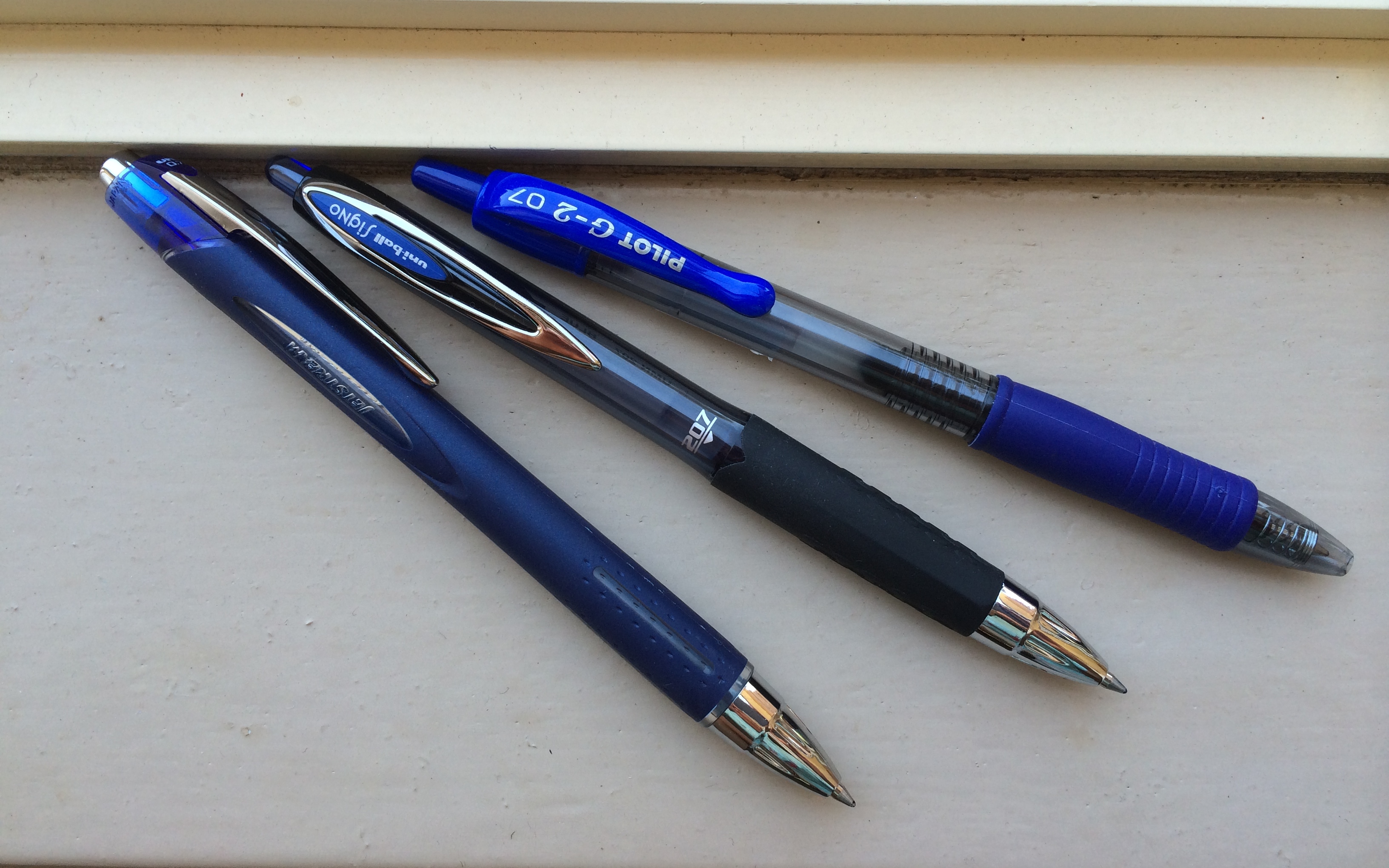A pen is generally a basic necessity for writing. Like most tools, they come in a variety, ranging from colors, sizes, and even shapes. All pens are specially designed according to one’s requirements. For this reason, it is important to choose the right and best pens for the job.
Many times, finding the perfect pen for the intended occasion can prove to be quite a problem. The market today is full of overpriced, substandard pens. If you’ve had any experience with them, then you can bear witness to how often they leak and dry haltingly. Needless to say, they hardly help when it comes to writing on success cards and birthday cards, as they leave them looking untidy, if not sketchy.
Keeping this in mind, it is only pertinent to consider looking for a better and equivocal writing tool. To start off, take into account what the pen’s purpose will be. Afterward, pick out the ink color, embodiment design and tip size of your preference in pursuance of maximum convenience.
If you want to have the best writing experience; free from constant seeping and untidiness, get yourself the uni-ball jetstream. It goes for an economical price and comes in all sorts of colors and designs. It has terrific ink movement that prevents leakage. Moreover, it dries fast and is suitable for any occasion.
Who this is for
Most people you come across don’t particularly care what type of pen they are writing with, so long as it writes. However, there’s a discernible difference between a high-quality pen and a mediocre one, and all it takes to truly experience the difference is a few dollars. Admittedly enough, they aren’t for everyone. You’re more suited to get one if you do a lot of writing, calligraphy or simply care a whole lot about what your handwriting looks like,
A decent pen has a number of characteristics that make it stand out from the normal sharp-pointed or ball-point pens you may be used to. It provides a marginally better writing experience, but compound this over a great number of hours of scribbling and you have quite a significant improvement on your hands. Even if you’re a professional writer, there are still chances you won’t fall in love with the pen, or perhaps you won’t notice any real difference from your usual writing experience. The worst case scenario is you’re down a few dollars, which isn’t too bad if you take a different perspective.
Three Types of Pens
There are three general categories of pens that are cheaply available on the market as of now. Excluding fountain pens, these are ballpoint, gel, and rollerball pens. All three are fairly similar from a third-person outlook with their own advantages and downsides, but each excels in specific areas over the other.
Fountain Pens
Fountain pens are usually more expensive than these three, and while there are some that can be found cheaply on the market, they are hard to find within the USA.
Ballpoint Pens
Ballpoint pens are the father of innovation in the pen world and marked a significant improvement from the previously widespread use of fountain pens. If you’ve ever used a fountain pen, especially one that wasn’t very well kept, you know the woes of having a pen with a horrible ink disbursement and a chipped nib. The ballpoint was invented to fix this – better ink dispersion and in itself, better ink that dries up faster. No more smudging.
Roller Pens
Rollerball pens use water-based ink, unlike oil-based ballpoint pens. This means finer lines and generally, require much less pressure to produce a beautiful effect. The ink tends to dry up a lot more slowly though, which means the pen will tend to bleed a lot or you may end up easily smudging the ink.
If you’re the pedantic type, gel pens are technically a variant of rollerball pens. The only real difference is they use more viscous ink, so they tend to bleed a lot less than actual rollerballs, all the while still providing a similarly smooth writing experience. They still do have smudging and drying problems though, so if that’s one of your pet peeves, this variant isn’t for you.
Most of the downsides we’ve mentioned can easily be contained with a general better design of the pen and better ink technology, so they shouldn’t be absolute deal breakers for you.
When selecting your pen, what you should be looking for is the ability to write a beautiful, even line and present an even flow of ink. Skipping is a definite no-no. The ink has to dry quickly and leave no smears and be suitable even for left-handers (a lot of design paradigms are followed during the design process, and most times only cater for the majority, who are right-handed).
It shouldn’t feather and shouldn’t be able to be spotted through the other side of the paper – this means it shouldn’t require so much pressure to produce comfortable results. Lastly, it has to be reliable, even for long-term use. If you misplace it and end up finding it again after a few months, the nib shouldn’t have completely dried out and still be good to use.
The Chemistry Of Ink
Ink is a liquid or pasty substance that usually contains a dye for coloring and used in the different variety of pens to write and draw. Ink can also be composed of several various components, including dyes and resins, all of which serve their own unique purposes. These components subsequently affect the rate of flow, color, thickness and dry appearance of the ink. Additionally, they affect one important factor that is single-handedly able to set a good and bad pen apart: how easily the ink can bond to the paper. Ink is able to stick to paper because the ink has a high affinity for paper.
These may not specifically affect your choice of ink, but if you want to write on surfaces that are not precisely paper or looking for ink that takes the shortest amount of time to dry, the chemistry is here to support your cause.
Why does ink stick to some surfaces and not others?
There are essentially two categories of ink (the ones in mass production and often used, that is). These are hydrophobic ink (made from non-polar compounds that don’t like water) and hydrophilic inks (which are made from polar compounds and will bond with water). If the ink is thrown onto a medium it doesn’t interact well with, it aggregates (clumps together) to avoid interaction with the surface. This way, inks won’t be able to write on, say a nylon paper. When the inks do favor the surface, however, they bond with the surface through a series of complex intermolecular forces.
Why do some inks take longer to dry?
Ink is made of various compounds, the most important of which is a solvent to make the ink mobile. It will remain so until the solvent has completely evaporated. Essentially, the dry time is tied to this rate of evaporation. This is why it’s much longer in oil-based pens.
Our picks for the best pen
The winner: Uni-ball Jetstream
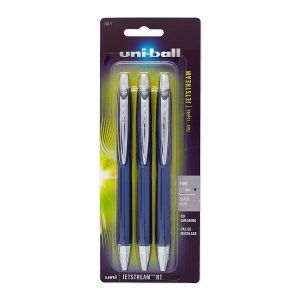 When it comes to a pen that’s great for everyday use, regardless of your writing frequency, the Uni-ball Jetstream pen is practically uncontested. It features an incredible combination of perfectly smooth and even ink, dries quickly and has excellent durability. Even after being subjected to long-term use, the Uni-ball Jetstream does not bleed or feather.
When it comes to a pen that’s great for everyday use, regardless of your writing frequency, the Uni-ball Jetstream pen is practically uncontested. It features an incredible combination of perfectly smooth and even ink, dries quickly and has excellent durability. Even after being subjected to long-term use, the Uni-ball Jetstream does not bleed or feather.
The Uni-ball’s strongest traits are its ease-of-use and ink properties that make writing with it a breeze for anyone who’s mostly used to normal ball-point pens. The ink it uses sets it apart even further than regular oil-based ink with its quick-drying performance and how easily it flows across the paper as compared to other more effusive models. Furthermore, the ink brings with it more resistance to common fraud disasters as check washing and identity theft associated with normal pen models. The ink bonds to the paper’s fibers, rather than simply spreading out and filling the holes in the paper, like normal pens usually do. This makes it resistant to the chemicals that wash off dye-based inks from checks and such. Extra points for security.
Various Models of the Uni-ball
There are various models of the Uni-ball to choose from: ranging from .3 mm versions to the 1mm version. The .3 mm range versions may seem like a long shot to invest in, but despite the thin tip, they don’t scratch the surface at all. They require very little pressure to achieve a respectable result and provide very smooth, fine writing. The .5 mm version similarly has similar advantages – a thin nib with minimum friction and a fine, gliding feel as you write across the page. The .7 mm version has almost no difference from the .5 mm apart from thicker lines – a result of a thicker nib. The finer nib versions do have braver, darker colors than the thin pens, so if you have an eye for art, they should be your pick.
Skipping is an infrequent occurrence, but as with nearly any pen, it can happen at certain angles of writing. As a rule of thumb, the thinner the nibm the less likely the pen is going to skip.
Which version should you get?
You may have noticed there are quite a plethora of pens to choose from. From all these variants, it may be somewhat difficult to know what you should go for. They are available from .38mm up to 1 mm. They also come in a range of colors. For most people, the .7mm version should suffice thanks to their retractables, which fit the largest variety of handwriting styles.
The 1mm version of the pen is for those who prefer to use something larger and if you’re still stuck in between, the 0.5mm version should be a great pick for you. The .38mm version is for people with extra fine nib requirements.
The runner-up: Uni-ball Jetstream Premier
If you’re one for a bolder line or a bigger body with a soft grip, give the Jetstream Premier a chance. It has a unique, sleek design that feels right at home while you use it. In the end, it comes down to personal preference and basic need for color, style, and size as you filter through the variety available.
a chance. It has a unique, sleek design that feels right at home while you use it. In the end, it comes down to personal preference and basic need for color, style, and size as you filter through the variety available.
Second runner-up: Uni Jetstream Alpha-Gel
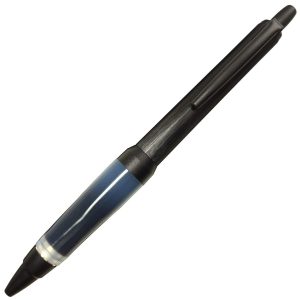 The Jetstream Alpha-Gel goes out to all the people who prefer a softer grip instead. Softer grips are perfect for long writing sessions, like college essays or lectures. It’s the complete opposite of the Premier, with a small body and much thinner ink. It also has a metal body, in contrast to the Premier’s plastic casing, so it should be a bit more durable.
The Jetstream Alpha-Gel goes out to all the people who prefer a softer grip instead. Softer grips are perfect for long writing sessions, like college essays or lectures. It’s the complete opposite of the Premier, with a small body and much thinner ink. It also has a metal body, in contrast to the Premier’s plastic casing, so it should be a bit more durable.
Third runner-up: Uni-Ball Style Fit
The Style Fit is a combination of the winning characteristics of both pens mentioned above, literally. It features a bold, well-designed body, comfortable grip and best of all, you can slot refills from either Signo or Jetstream into its body and use it as needed.
literally. It features a bold, well-designed body, comfortable grip and best of all, you can slot refills from either Signo or Jetstream into its body and use it as needed.
Best Pens: The competition
For general use, two pens stand out: the uni-ball Signo 207, and the Pilot Precise V5. They are both fine pens, that you would no doubt enjoy using, but don’t quite level up to the Jetstream.
Signo 207
 The Signo 207 is a well-performing pen. It’s worth noting that in terms of uniformity of line, fineness of the resulting line and pressure required, the Signo was better than the Jetstream. What let it down is that it didn’t do so great in other categories. Writing with it isn’t as fine and smooth as with the Jetstream. Furthermore, it’s not as durable and more prone to skipping and bleeding. Since it uses oil-based ink, it’s also slow to dry. It does win points for producing bold lines and coming in an array of bright colors, where it leads the pack.
The Signo 207 is a well-performing pen. It’s worth noting that in terms of uniformity of line, fineness of the resulting line and pressure required, the Signo was better than the Jetstream. What let it down is that it didn’t do so great in other categories. Writing with it isn’t as fine and smooth as with the Jetstream. Furthermore, it’s not as durable and more prone to skipping and bleeding. Since it uses oil-based ink, it’s also slow to dry. It does win points for producing bold lines and coming in an array of bright colors, where it leads the pack.
Pilot Precise V52
The Pilot Precise V52 is a classic in the pen world. Together with its lesser brother the V7, they were lots of people’s first introduction to what a better pen really means. It holds the crown for best-selling rollerball pen in the US since it’s creation in 1986. However, that crown is one of the reasons it’s not first on the list. It’s woefully lacking in anything innovative, and its intermediate brother, the V5, doesn’t hold the mettle as well as the other two entries.
they were lots of people’s first introduction to what a better pen really means. It holds the crown for best-selling rollerball pen in the US since it’s creation in 1986. However, that crown is one of the reasons it’s not first on the list. It’s woefully lacking in anything innovative, and its intermediate brother, the V5, doesn’t hold the mettle as well as the other two entries.
Depending on how you look at it, the outer design of the pen is either classic or outdated, and since it’s a water-based pen, it’s more bound to feather and dry in the body. However, when it meets paper, it dries up pretty quickly, which is a sort of redemption. It stands up to the competition in terms of comfort but lacks the smoothness and durability previous entries possess.
Pilot G2
 The Pilot G2 is an insanely popular gel pen, but in our experience, its performance isn’t as impressive as the flashy ads would have you believe. The body’s design doesn’t resonate with the quality of newer pens and is woefully unreliable to use over the long term. It’s design features make it prone to skipping, globbing and feathering, besides not providing the smoothest writing experience you’ll get. It isn’t the worst money can buy, there are far worse, but still.
The Pilot G2 is an insanely popular gel pen, but in our experience, its performance isn’t as impressive as the flashy ads would have you believe. The body’s design doesn’t resonate with the quality of newer pens and is woefully unreliable to use over the long term. It’s design features make it prone to skipping, globbing and feathering, besides not providing the smoothest writing experience you’ll get. It isn’t the worst money can buy, there are far worse, but still.
Best Pens: Honorable mentions
Pens that appear in this category managed to slip their way into the list because they are either popular with writers or earned favorable reviews on Amazon or other online stores. However, these weren’t enough to get them the attention we’ve given our other picks.
Pilot Hi-Tec C/G-Tec C
The Pilot Hi-Tec C/G-Tec C is famous for its fine tip, which you can find down to the  thinnest 0.25 mm version. However, the widest version you can find is the .4mm pens, which are just too thin for most people. They’ll find themselves either scratching the surface or bending the tip. Additionally, they aren’t easy to find in stock.
thinnest 0.25 mm version. However, the widest version you can find is the .4mm pens, which are just too thin for most people. They’ll find themselves either scratching the surface or bending the tip. Additionally, they aren’t easy to find in stock.
Zebra Surari
 The Surari is yet another great ballpoint pen that uses emulsion ink (oil-based with additives) but it’s similarly hard to run into in the US.
The Surari is yet another great ballpoint pen that uses emulsion ink (oil-based with additives) but it’s similarly hard to run into in the US.
Zebra Sarasa
The Zebra Sarasa is just as high-performing as the Signo 207 but has a thinner tip and more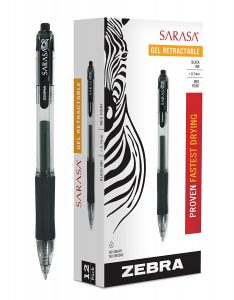 scratchy qualities.
scratchy qualities.
Sharpie Pen
 Not to be confused with the regular Sharpie, is a very durable pen. It comes with a primarily stainless steel body. Plus a high performing tip that’s porous enough to be great for everyday writing. However, the same quality of the tip does make it prone to leaking and issues with drying out.
Not to be confused with the regular Sharpie, is a very durable pen. It comes with a primarily stainless steel body. Plus a high performing tip that’s porous enough to be great for everyday writing. However, the same quality of the tip does make it prone to leaking and issues with drying out.
Pentel Slicci
When it comes to grip, Pentel Slicci wins full marks, just not anywhere else. The lines it brings out aren’t too smooth and tends to smudge a lot.
Pilot Dr. Grip
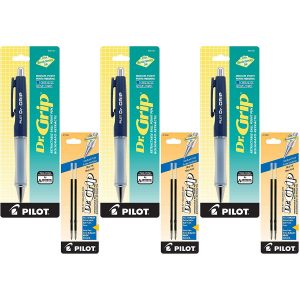 The Pilot Dr. Grip is pretty well-liked because of the ink cartridge it comes with. Once again, it doesn’t have anything else worth pointing out. Because the lines aren’t all too clear and it makes for an overall mediocre pen.
The Pilot Dr. Grip is pretty well-liked because of the ink cartridge it comes with. Once again, it doesn’t have anything else worth pointing out. Because the lines aren’t all too clear and it makes for an overall mediocre pen.
Pilot Acroball
Pilot definitely know their way with ink, because no model thus far has failed us. The Pilot Acroball falls in the same category. If anything, it’s nearly at par with Jetstream, but it tends to skip and feather quite often.
falls in the same category. If anything, it’s nearly at par with Jetstream, but it tends to skip and feather quite often.
Uni-ball Vision Elite
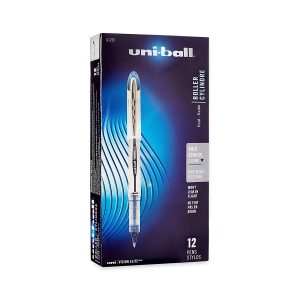 The Uni-ball elite isn’t as well performing as it’s brothers. Despite the fact it makes for a wonderful choice for writing on quality paper, anything below that and you’re back to fountain pens on overly-absorbent paper.
The Uni-ball elite isn’t as well performing as it’s brothers. Despite the fact it makes for a wonderful choice for writing on quality paper, anything below that and you’re back to fountain pens on overly-absorbent paper.
It’s slower to glide across the paper and will tend to smudge or spot through the other side but otherwise makes for a good choice (if you can get a good paper, of course).
How to use pens better
It would be pretentious of us not to finish off without mentioning there are quite a few mistakes people make that will end up scratching or spotting the surface of the paper. Sure, at times the fault is with the pen (as is often the case), but other times, you’re just using too much pressure when writing. If you’re using a very fine tip, especially, this is something to look out for. Don’t grip the pen with so much force. Just let the pen flow and if the ink is good enough, it should glide on the surface easily.
On that note, the quality of the paper you use will be one of the highest determining factors when it comes to writing quality. No matter how great the pen you’re using it, it’s performance is tied down to the kind of writing surface you use it on. Thinner paper tends to be easier to bleed through and rough paper will give you far less even lines. Your writing experience can be greatly improved if you check what you’re writing on. A poor quality paper will bring down a great pen, and vice versa in the case of a terrible pen.
As mentioned before the ink works differently. Some ink is simply absorbed in microscopic holes in the paper while others bond with the paper’s material directly. The kind of ink you go for should be compatible with your writing surface, too. For instance, fountain pens don’t do too well on rough paper.

